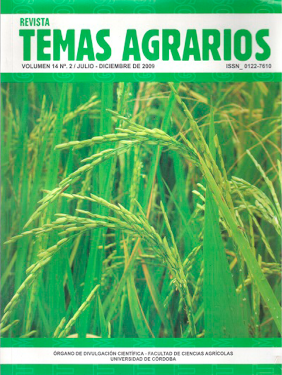Biology of the predatory Amblyseius herbicolus MITE (Acari: Phytoseiidae) feeds on pollen and on Tetranychus urticae
Biologia Do Àcaro Predador Amblyseius Herbicolus Alimentado por Pólen e Pela Presa Tetranychus Urticae
How to Cite
Oliveira, H., Fadini, M., Rezende, D., Soto Giraldo, A., Girón Pérez, K., Aramendiz Tatis, H., & Pallini, A. (2009). Biology of the predatory Amblyseius herbicolus MITE (Acari: Phytoseiidae) feeds on pollen and on Tetranychus urticae. Sour Topics, 14(2), 43-45. https://doi.org/10.21897/rta.v14i2.674
Dimensions
license

This work is licensed under a Creative Commons Attribution-NonCommercial 4.0 International License.
Show authors biography
/
/
‑0
1
1 /
‑2
In population risings accomplished in strawberry plant cultivations, A. herbicolus was found in plants infested by the two-spotted mite Tetranychus urticae Koch (Acari: Tetranychidae). T. urticae is the main curse strawberries’ plants, exists a constant search of new species with potential agent of biological control against that phytophagous. This way, the objective of that work was to evaluate the biology of the predaceous mite A. herbicolus when fed by diets composed by castor oil plant pollen, T. urticae and the association of castor oil plant pollen and T. urticae. Those diets constituted the treatments of the experiment that it was driven under controlled conditions (T = 25±2ºC, RH = 65±10% and photoperiod 13:00h (L:D) on arenas made with strawberries’ leaves (Ø = 2.5 cm). The results demonstrated that the juvenile phase of the predaceous mite A. herbicolus is just completed when the same was fed by pollen and by pollen and T. urticae. The largest longevity of the predator was observed when the same was fed by the diet composed just by pollen, however larger oviposition tax was observed when A. herbicolus was fed by the association of the pollen diets and T. urticae. The obtained data demonstrated that the predaceous mite A. herbicolus reaches the adult phase only when fed by diets containing pollen. However, in the adult phase, A. herbicolus needs if it feeds from diets to the base of T. urticae to obtain larger energy and like this, consequently to present reproductive potential adult.
Article visits 949 | PDF visits
Downloads
Download data is not yet available.
- Ali, F. 1998. Life tables of Phytoseiulus macropilis (Banks) (Gamasida: Phytoseiidae) at different temperatures. Experimental and Applied Acarology 22(8):335-342.
- Badii, M., Hernandez-Ortiz, E., Flores, A. y Landeros, J. 2004. Prey stage preference and functional response of Euseius hibisci to Tetranychus urticae (Acari: Phytoseiidae, Tetranychidae). Experimental and Applied Acarology 34(3):263-273.
- Bakker, F., Klein, M., Mesa, N. y Braun, A. 1993. Saturation deficit tolerance spectra of phytophagous mites and their phytoseiid predators on cassava. Experimental and Applied Acarology 17(2):97-113.
- García-Marí, F. y González-Zamora, J. 1999. Biological control of Tetranychus urticae (Acari: Tetranychidae) with naturally occurring predators in strawberry plantings in Valencia, Spain. Experimental and Applied Acarology 23(6):487–495.
- Helle, W. y Sabelis, M. 1985. Spider mites. Their biology, natural enemies and control, Elsevier, Amsterdam, 458p.
- Krips, O., Witul, A., Willems, P.y Dicke, M. 1998. Intrinsic rate of population increase of the spider mite Tetranychus urticae on the ornamental crop gerbera: intraspecific variation in host plant and herbivore. Entomologia Experimentalis et Applicata 89(26):159-168.
- McMurtry, J. y Croft, B. 1997. Life-styles of Phytoseiid mites and their roles in biological control. Annual Review of Entomology 42(1): 291-321.
- McMurtry, J., Huffaker, C. y Van de Vrie, M. 1970. Ecology of tetranychid mites and their natural enemies: a review. I. Tetranychid enemies: their biological characteres and the impact of spray pratices. Hilgardia 40(11): 331-390.
- Moraes, G., McMurtry, J., Denmark H. y Campos, C. 2004. A revised catalog of the mite family Phytoseiidae. Zootaxa 434:1- 494.
- Moraes, G. 2002. Controle biológico de ácaros fitófagos com predadores, p.225-237. In J.R.P.
- Parra, P.S.M. Botelho, B.S. Corrêa-Ferreira & J.M.S. Bento (eds.), Controle biológico no Brasil: Parasitóides e predadores. São Paulo, Manole, 635p.
- Moraes, G. 1991. Controle biológico de ácaros fitófagos. Inf. Agropec. 15:53-55.
- Opit, G., Nechols, J., Margolies, D. y Williams, K. 2005. Survival, horizontal distribution, and economics of releasing predatory mites (Acari: Phytoseiidae) using mechanical blowers. Biological Control 33(3): 344-351.
- Osborne, L., Ehler, L. y Nechols, J. 1985. Biological control of the twospotted spider mite in greenhouses. Bulletin 853, Institute of Food and Agricultural Services, University of Florida, Gainesville, 40p.
- Reis, P., Teodoro, A., Neto, P. y Silva, E. 2007. Life history of Amblyseius herbicolus (Chant) (Acari: Phytoseiidae) on coffee plants. Neotropropical Entomology. Apr. 36 (2):282-287
- Skirvin, D. y Williams, M. 1999. Differential effects of plant species on a mite pest (Tetranychus urticae) and its predator (Phytoseiulus persimilis): Implications for biological control. Experimental and Applied Acarology 23(2):497-512.
- Shih, C. y Huang, J. Functional responses of Amblyseius womersleyi preying on the kanzawa spider mite. En: Dusbabek, F. y Bkva, V. (Ed.). Modern Acarology, Academia, Prague and SPB Academic Publishing bv, The Hague. p481-486.
- Thongtab, T., Chandrapatya, A. y Baker, G. 2001. Biology and efficacy of the predatory mite, Amblyseius longispinosus (Evans) (Acari, Phytoseiidae) as a biological control agent of Eotetranychus cendanai Rimando (Acari, Tetranychidae). J. Appl. Entomol. 125(2):543-549.
- Van Houten, Van Rijn, P., Tanigoshi, L., Van Stratum, P. y Bruin J. 1995. Pre-selection of predatory mites to improve year-round biological control ofwestern flower thrips in greenhouse crops. Entomol. Exp. Appl. 74(3):225-234.
- Zhang, Z. y Sanderson, J. 1995. Twospotted spider mite (Acari: Tetranychidae) and Phytoseiulus persimilis (Acari: Phytoseiidae) on greenhouse roses: Spatial distribution and predator efficacy. J. Econ. Entomol. 88 (2): 352-357.




















